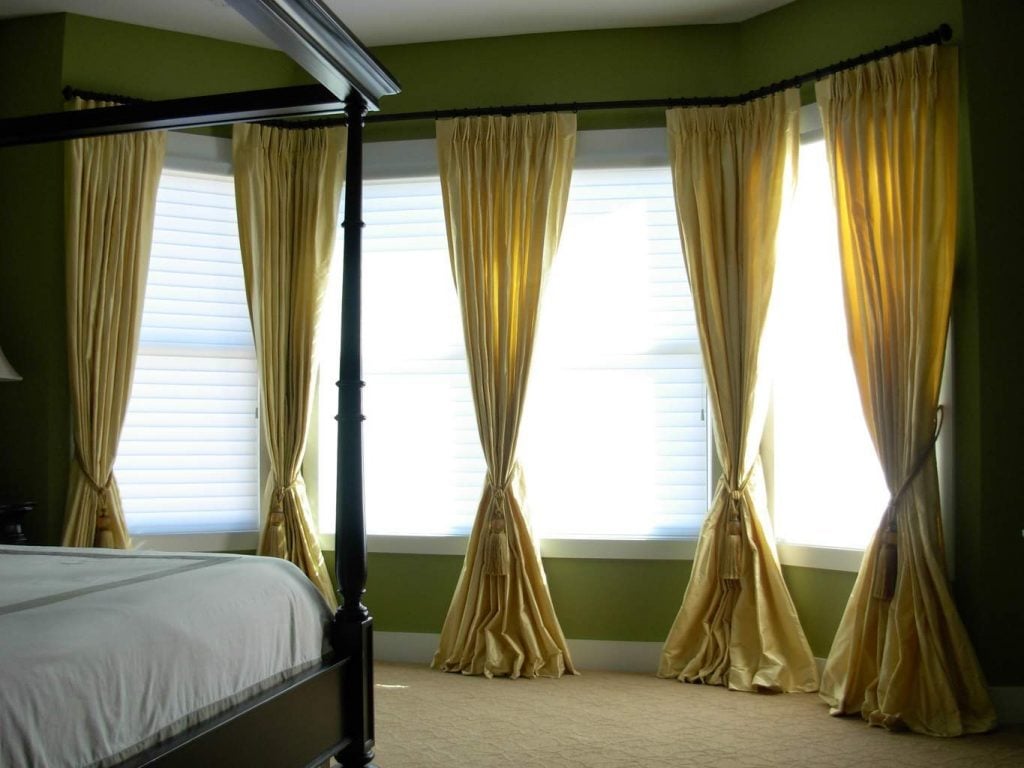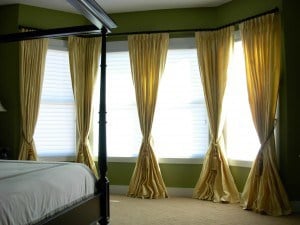Your Journey to a Beautiful Home Starts at Sunshine Drapery
Receive a complimentary professional in-home design consultation today!

Like many homeowners, you’ve probably thumbed through the pages of a Better Homes & Gardens magazine and admired the draperies showcased in a family’s living room renovation. You pause and study the draperies in the pictures, wishing you could have the same “wow” factor in your rooms without having to take out a second mortgage. We recognize the process of selecting the right drapery fabric for your rooms can be overwhelming. Understanding the benefits of different types of fabrics available makes the process much easier. Here are some tips for selecting the right fabric for your home’s draperies.
 When it comes to choosing the right fabric for your home’s draperies, the weight of the fabric is essential to achieving the look you’re hoping to achieve. If the fabric is too light, your draperies may not hang from the rod the way you’d hoped, looking too flimsy in some cases. If the fabric is too heavy, your draperies may not form the neat pleats you’d hoped for.
Another consideration is the type of heading you’d like for your curtains or drapes. The reason why so many people choose modern eyelet headings is because they’re ideal for medium weight fabrics which form their own wave effect pleats because of the nature of the heading. If you prefer eyelet curtains, cotton, linen and polyester-cotton blend fabrics are ideal.
If you prefer standard pencil pleat headings, you’ll want to look for medium to heavy weight fabric. Fabrics like Damask, Jacquard, velvet and natural linens have the suppleness required for pleats to be formed correctly. These types of fabrics are ideal for making draperies that are pleated.
Medium weight cotton, polyester-cotton blends and faux silks are fabrics that have the rigidity to make them hang correctly if a goblet or inverted pleat is the look you’re after in your rooms. But if you’re after a lighter look, go for tab top curtains lightweight sheers, voile or faux silk for natural movement in fluidity.
Once you’ve identified the weight you need to support your drapery design, you’re ready to consider color. When it comes to selecting the right fabric for your room’s draperies, it’s important to understand how different colors work together. It’s also important to remember that harsh sunlight in south-facing rooms can quickly fade curtain fabrics. Keeping this in mind, it’s best to avoid bright colored fabrics which fade more quickly compared to fabrics in neutral tones. However, if you’re one of the fortunate who are able to change window dressing frequently, this doesn’t pose a real problem. However, natural colors are less prone to fading and suit most color schemes. For rooms that get lots of sunlight, consider faux silk, cotton and polyester-cotton blends.
While nearly everyone is trying to reduce their utility bills, choosing the right fabric for your room’s draperies can help to keep your rooms warmer in winter and cooler in summer. To retain heat and block out sunlight in your rooms, consider heavy to medium weight Damasks, Jacquards, velvet and faux suede. But if you can’t live without a cotton or cotton-polyester blend fabric for your drapes, there’s peace of mind that comes with knowing virtually any curtain fabric can be lined with Sunshine Drapery’s standard, thermal or blacking lining fabric.
When it comes to choosing the right fabric for your home’s draperies, the weight of the fabric is essential to achieving the look you’re hoping to achieve. If the fabric is too light, your draperies may not hang from the rod the way you’d hoped, looking too flimsy in some cases. If the fabric is too heavy, your draperies may not form the neat pleats you’d hoped for.
Another consideration is the type of heading you’d like for your curtains or drapes. The reason why so many people choose modern eyelet headings is because they’re ideal for medium weight fabrics which form their own wave effect pleats because of the nature of the heading. If you prefer eyelet curtains, cotton, linen and polyester-cotton blend fabrics are ideal.
If you prefer standard pencil pleat headings, you’ll want to look for medium to heavy weight fabric. Fabrics like Damask, Jacquard, velvet and natural linens have the suppleness required for pleats to be formed correctly. These types of fabrics are ideal for making draperies that are pleated.
Medium weight cotton, polyester-cotton blends and faux silks are fabrics that have the rigidity to make them hang correctly if a goblet or inverted pleat is the look you’re after in your rooms. But if you’re after a lighter look, go for tab top curtains lightweight sheers, voile or faux silk for natural movement in fluidity.
Once you’ve identified the weight you need to support your drapery design, you’re ready to consider color. When it comes to selecting the right fabric for your room’s draperies, it’s important to understand how different colors work together. It’s also important to remember that harsh sunlight in south-facing rooms can quickly fade curtain fabrics. Keeping this in mind, it’s best to avoid bright colored fabrics which fade more quickly compared to fabrics in neutral tones. However, if you’re one of the fortunate who are able to change window dressing frequently, this doesn’t pose a real problem. However, natural colors are less prone to fading and suit most color schemes. For rooms that get lots of sunlight, consider faux silk, cotton and polyester-cotton blends.
While nearly everyone is trying to reduce their utility bills, choosing the right fabric for your room’s draperies can help to keep your rooms warmer in winter and cooler in summer. To retain heat and block out sunlight in your rooms, consider heavy to medium weight Damasks, Jacquards, velvet and faux suede. But if you can’t live without a cotton or cotton-polyester blend fabric for your drapes, there’s peace of mind that comes with knowing virtually any curtain fabric can be lined with Sunshine Drapery’s standard, thermal or blacking lining fabric.
)
Receive a complimentary professional in-home design consultation today!